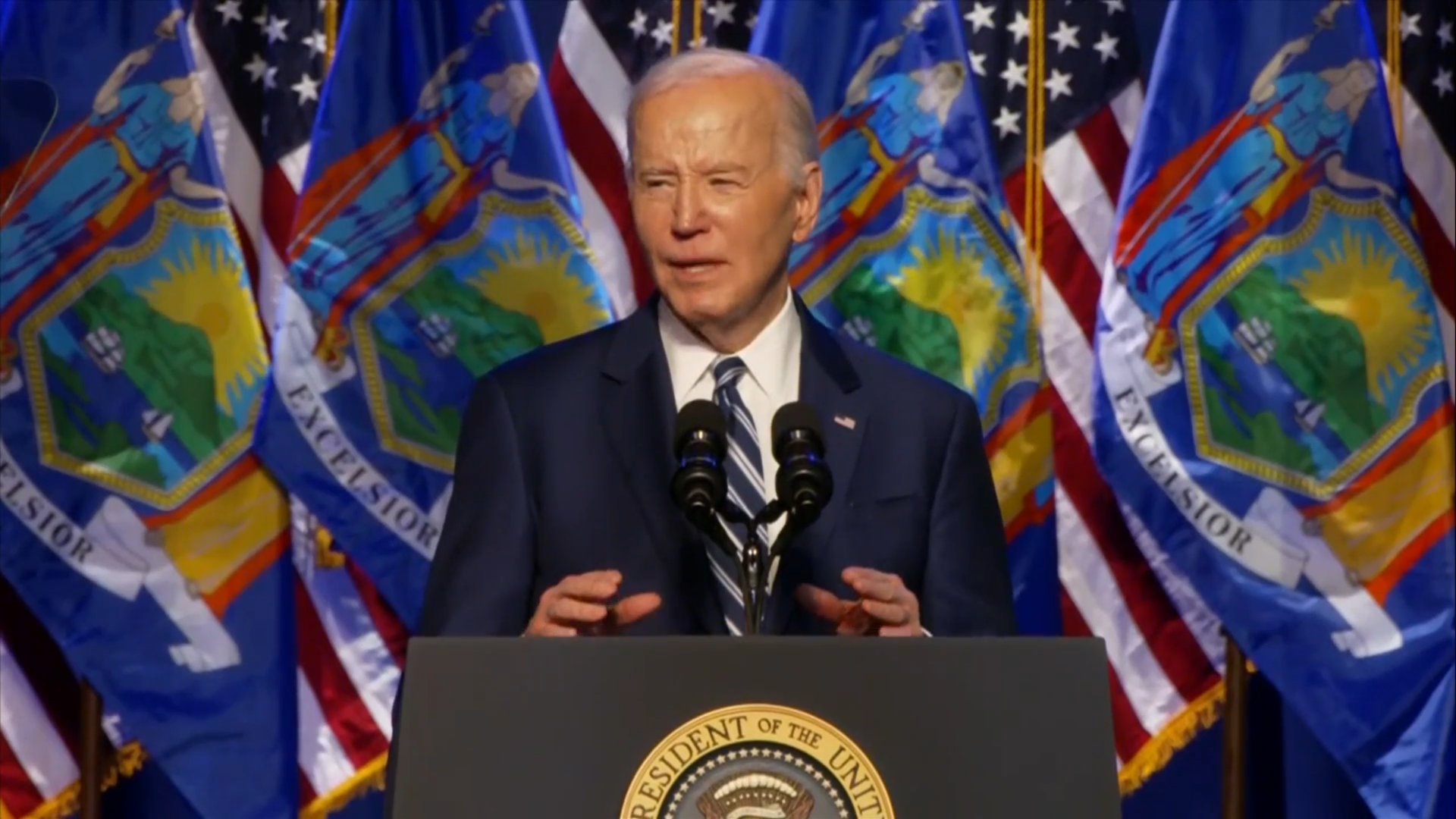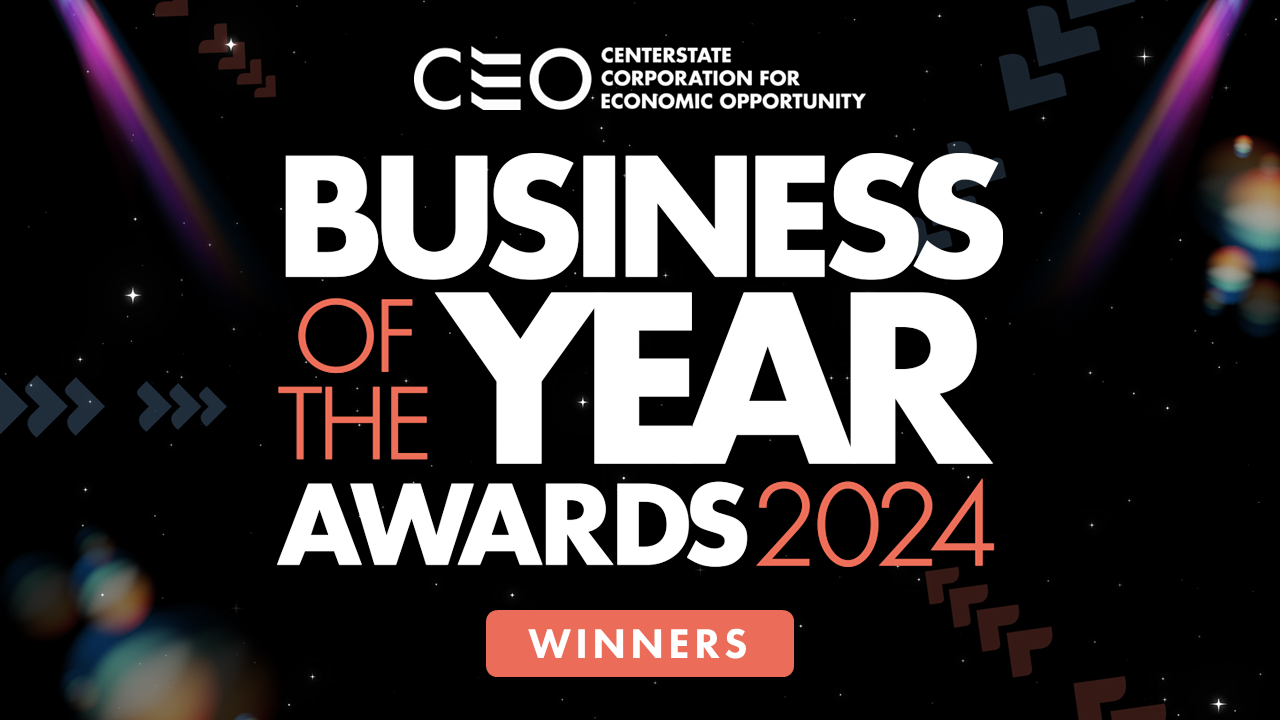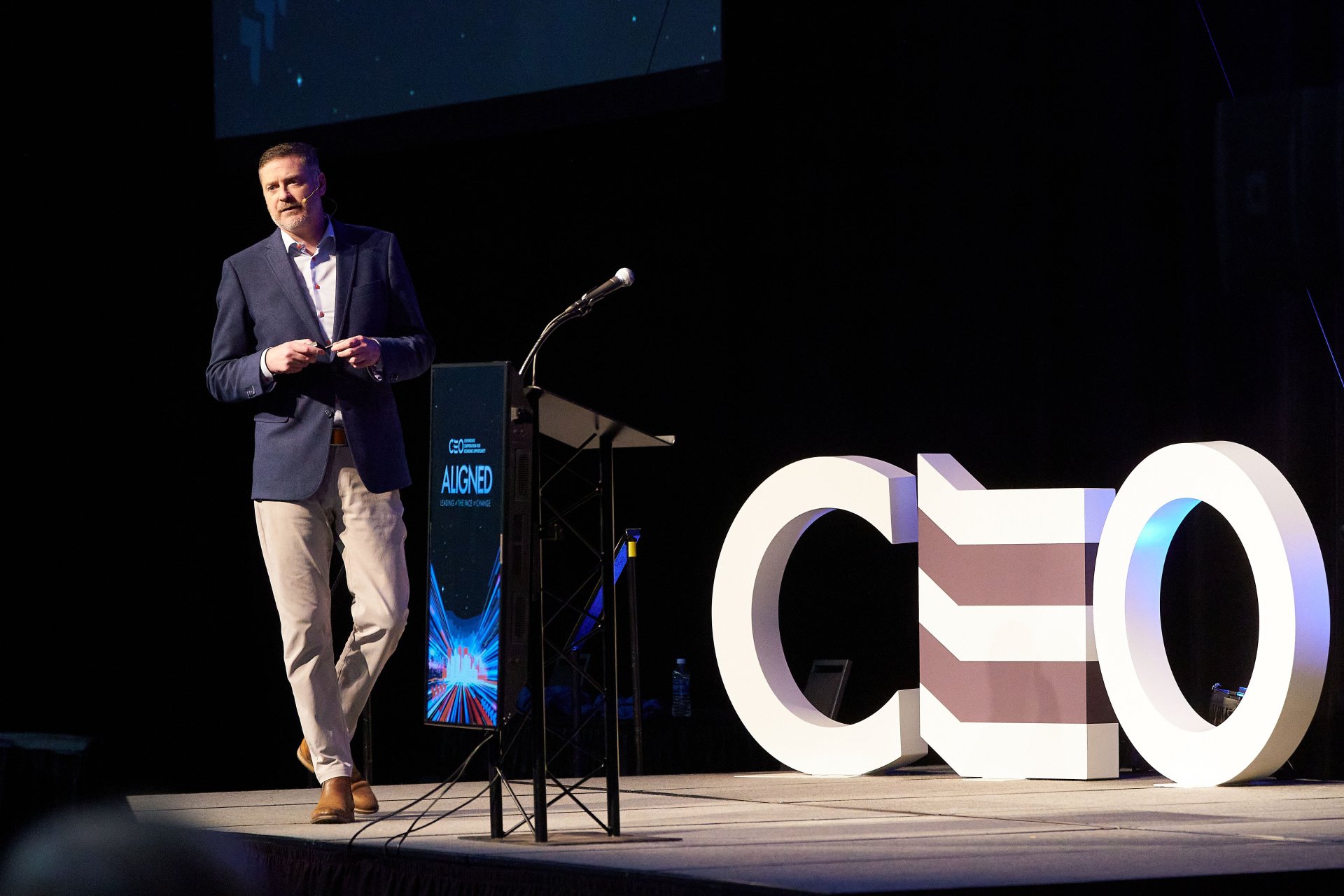Remarks by CenterState CEO President Robert M. Simpson, 2021 Economic Forecast EventPosted on January 27, 2021 |
Image

|
Good morning.
Let me begin by saying thank you to St. Joseph’s Health, and M&T Bank. Year after year, you support this event and our agenda for economic growth and shared prosperity in Central New York and for that we are grateful.
To our members and partners who have joined us today, thank you also. The day that we resume these events in person will indeed be a joyous one, but for now it is nice to have these virtual spaces to share and stay connected.
And to our staff at CenterState CEO, what you have accomplished this past year, despite difficult circumstances and impossible odds, is nothing short of remarkable. You have maintained our programing and presence in the community, served more members than ever in a time of exceptional need, and supported colleagues, friends and loved ones through sickness and hardship. And you did it all with kindness and grace, showing up for our community and each other in ways that I will never forget. Individually and collectively, you all make this organization what it is. And for that I thank you.
As much as today is about reflecting on and putting into context the economic pressures and trends of the past year, it is also about laying the groundwork for how we approach the opportunities before us. For while this pandemic may have slowed us down and put some of our ambitions on pause, it cannot, and will not, stop us from achieving our vision for this region as a place where business thrives and ALL people prosper.
First the challenges. As Gary Keith rightfully pointed out there are real headwinds facing our economy. Most of these trends are not unique to Central New York but rather reflective of a national and international economy battered by a plague that has taken both life and the freedom of movement upon which a modern economy depends.
That sentiment was echoed by our Forecasters, who shared the challenges they faced in 2020 and a much more muted sense of optimism – especially compared to recent reports – of what they see for 2021.
- 42% described their outlook for the strength of their business in 2021 as strong or very strong; down 34% from 2020 when 76% described their outlook as such.
- 44% expect sales or revenues to increase in 2021, down 26% from 2020
- 42% expect to expand product and services in 2021, down 18% from 2020 projections.
- 39% expect an increase in jobs and hiring in 2021, down 26% from 2020 projections.
- 34% expect to increase capital investments, down 15% from 2020 projections.
These projections for the year ahead are sobering, and reflect a sentiment that our region’s business leaders have not felt in more than a decade and a half. They represent a clear reflection of the incredible stressors brought on by nearly a year of pandemic-driven uncertainty that has impacted every aspect of our lives.
And yet, when I sat down to think about the message I wanted to deliver to you today -- one that I hope you’ll carry out of this virtual gathering and into your own conversations about what the future holds for this region– I found myself focusing not just on the data and the fundamentals, but on a broader narrative and civic arc.
This is not the first time Syracuse and Central New York have faced difficult times. In fact, each of us wo has called this place home for any measure of time can recount story after story of economic hardship. Or civic ineffectiveness. Or of the sheer human impact of layoffs, of our youth moving away, or of entire communities like the 15th ward demolished in an act of racial segregation and trauma.
No, this region has faced tough times before. Vast, insurmountable economic and demographic forces have aligned and worked against us in the not so distant past and yet – yet – in February of last year this community was celebrating its greatest level of economic success than we had in decades.
That is just one of the many reasons that, while tired from the many tolls of this past year, I do not feel beaten. While disappointed, I have not lost hope. And while some may say that we can’t recreate the magic of this community’s renaissance, I say, “watch us.”
Let us not forget, this is not a normal economic crisis. This is an economic crisis driven by a public health crisis - a once in a hundred-year pandemic. And because this is a health driven crisis, we know that there is a clear way forward, with hope in the form of vaccines and new treatments. If we all do our part in the battle to defeat the virus - wear our masks, practice social distancing and when it is our turn, get vaccinated – we will emerge from the other side. This is one very clear example of how the choices we make as individuals impact us all and will dictate the pace at which we return to normal and accelerate our recovery.
Add to that this new and unique moment for our region where an alignment of federal leadership with real ties to Central New York might benefit this region in meaningful ways. A new president who lived on Tipp Hill and graduated from Syracuse University. A Senate Majority leader with ties to our region as well and whose presence here, pre-pandemic, was ubiquitous. Federal leadership –positioned to understand the unique challenges of cities like Syracuse and Oswego and Auburn and Utica, and support our efforts to help ourselves.
Congressman Katko, too, is in a new leadership position that can be leveraged to our region’s benefit as he continues to commit to working with other leaders across the aisle to make sure the work we need them to do gets done. We have seen the successes that follow when our local leaders cast aside political differences and fight not to be right or win, but to come to a shared vision to move us forward.
But what makes me truly hopeful is my unwavering belief in our capacity to rewrite our future because we have done so before. This region watched for decades as jobs and people left. We have been written off far too many times to count and yet, you didn’t give up. No, instead you rolled up your sleeves and you dug in. Pressed your shoulder to the plow and drove headfirst into those challenges that were standing in the way of our ambitions. We have fought back before and we will do it again.
Think back to the trajectory this community was on at the beginning of 2020 when Gary Keith delivered what we called his most optimistic forecast EVER. For years Gary has been telling us that our economy was marked by its slow and steady growth. He stood before you one year ago and said if we are to break that “no boom, not much bust” cycle then we need to continue to lean into our strategies because they were sound and progress was being made. And you just heard him say that if we recommit to that approach that those strategies will help drive us to a more prosperous and more resilient recovery.
When you look, the investments seeded over the past several years are taking root and becoming real. And just last week you heard the mayor share that the city’s investments in the Smart Cities and Syracuse Surge initiatives, which were mere concepts a year ago, are moving forward and on the cusp of unlocking untold opportunities for innovation in public service delivery, traffic management and data analytics. They also will help to bridge the very real gaps in digital inclusion that became even more obvious during this pandemic.
Projects like The Salt City Market - which opens tomorrow - JMA Wireless and the STEAM school continue to move closer to reality, and we can begin to see how these investments will be critical drivers of further growth. Each of these projects are tangible examples of our strategies in action – our intentional efforts to direct investments in the people and parts of our communities with untapped potential to better position them to be part of our growth, ambitions and greater prosperity.
Taken together with the expansion of The Tech Garden, these very projects, which will be realized in the next 12-18 months, will transform our communities through job creation and further cement Syracuse as a hub of tech innovation.
And a year ago, Amazon was just a name whispered quietly as people guessed what company was behind the development project in Liverpool. Have you driven by that building lately? Its massive, and when seeing it firsthand it is impossible not to also see the jobs and envision the follow-on development a project like will create in this community.
In Oswego County we are seeing investments come to life. A DRI investment of $10 million has leveraged an additional $96 million in private investment. Of the 12 projects these investments funded all are either completed or under construction.
Our focus on investing in livable communities is paying off. Each year more than thirty-five thousand people move to the Syracuse Metro area and most of them are between 18 and 39 years old. A recent study from the National Association of Realtors that looked at all metros in the U.S. showed that nearly 3 out of 4 or 73% of recent movers to this area were millennials. Initiatives like Generation Next are working to ensure that we can better attract and retain this talent, as well as foster opportunities and career advancement for diverse talent within our region.
We are also seeing this growth through real estate transactions as homes in Syracuse city neighborhoods sell almost as quickly as they come on the market. In August, the Greater Syracuse Association of Realtors reported that the One-Year change in median home price was up 17.2%. And while the number of new listings in August remained at pre-COVID-19 levels, the list price sellers received for those homes was over 100%.
We saw similar growth in downtown Syracuse last year when the residential population grew by 7.5% - the most downtown’s population has climbed in a single year since 2014. Over the last 10 years, downtown Syracuse has experienced an 88% surge in its population, a trend that is expected to continue as new housing comes onto the market.
This is incredible progress that began before this crisis and has only extended throughout this pandemic as people look to migrate form larger cities to places with slightly less density, more affordability, and a greater quality of life. Does that sound at all familiar?
And for those still doubting how quickly we can return to an economy where money circulates freely and people are back to work – how does a $2 billion infrastructure project starting in 2022 sound as a possible stimulant? Finally, after years of debate, disagreement and inertia, we have a preferred plan – the Community Grid – which includes many of the enhancements that CenterState CEO has advocated for in this process. And we now have a target date for construction to start with heightened odds of the necessary federal funding to complete it.
Now, our community’s focus can and must shift to how best maximize this opportunity and ensure that the Community Grid works for more people. Not only will it reshape our physical landscape and how people access our city, but it also provides an opportunity to make sure that the people in this community that need jobs have a clear pathway to those created by this project, particularly women and minorities. Efforts to ensure the local labor force and contractors are well-positioned to participate on this project are already underway. CenterState CEO is working with Mayor Walsh and County Executive McMahon to develop and launch Syracuse Build – a workforce initiative dedicated to developing career opportunities in construction-related fields for Syracuse residents, particularly from low-income communities and communities of color. As the economy begins to pick back up, and with work on I-81 on the horizon, Syracuse Build will produce a pipeline of qualified local workers for the Interstate 81 project.
Every one of these projects and the jobs and new investments they stand to bring provide hope for a stronger future. And this is just a sampling. There are other projects in the pipeline. Other reasons to believe that the future can and will be bright. And in just the first four weeks of the new year, the number of conversations we are having with business about new investment is picking back up, showing a renewed momentum and a reason for measured confidence.
But while there are plenty of reasons to be hopeful for our economic recovery, recovery cannot suffice as our only ambition.
If this pandemic and a new season of reckoning on issues of racial and social justice has laid anything bare, it is the ever-prevalent disparities between those traditionally positioned to benefit from these economic opportunities, and those that suffer from and are left behind by the structures of our current socio-economic systems.
Before the pandemic we were beginning to see slow progress when it comes to one of this community’s most persistent challenges: poverty. Overall, poverty went down in the city from 2014 to 2019 and if you had a job – any kind of job - the chances that you were in poverty fell the most. Poverty rates are higher for the unemployed, but from 2014 to 2019 it got worse; 53% of the unemployed were in poverty in 2019, compared to 50.7% in 2014. Of course significant unemployment caused by the pandemic has only made this worse.
We see a large disparity in the fact that women, particularly women of color, lost their jobs during the pandemic. Though women and men shared equally in the number of jobs in the workforce at the start of the year, job loss for women in 2020 was 1 million more than for men. In a year where 9.8 million jobs were lost, women accounted for 55% of that loss. This was due to significant job losses in female dominated sectors like education and retail.
Women also disproportionately stepped up to fill the gap in child care and education for their families. Among women, these job losses were felt most significantly among Latinas who currently have the highest unemployment rate at 9.1%, followed by Black women at 8.4% compared to white men who have an unemployment rate of 5.4%. In December alone 154,000 Black women nationwide left the labor force.
Recovering what we had just 12 short months ago – would unquestionably feel good to many. But to so many others who live amongst us in this community that notion of recovery – of going backwards -- represents a return to a system that is broken, unfair and unjust.
So today, I ask this of you: in solidarity, let us raise our aspirations for the year ahead beyond those of simple recovery to include a repair of our fractured social compact and a more equitable and inclusive approach to growth and development as we reinvent this region once again.
We all have work to do to make this possible. And I’m proud that CenterState CEO’s Board of Directors stepped forward to prioritize issues of corporate responsibility for racial and economic justice as part of its 2020-2021 Board Retreat strategic planning process.
Companies are actively engaging in our diversity, equity and inclusion training and services within our newly formed Racial Equity and Social Impact portfolio, led by Dr. Juhanna Rogers. Companies like Digital Hyve, National Grid, SOS, KS&R, OneGroup and SRC have begun to take tangible action steps and are investing in this work. The United Way, for its part, launched an incredible, ongoing effort to expand the community dialogue on equity issues, engaging nearly 100 partners and 3,500 of our neighbors in its 21 Day Challenge last fall. The incredible response we have seen is further evidence of this business community doing the work needed to create more equitable and welcoming workplaces and create more and better opportunities for all who do and will call Central New York home.
But these efforts are only a start. We can’t break the cycles and systems created over generations if only a handful of companies believe in and do this important work. And so I call on each of you to dig even deeper. On Monday, with support from Berkshire Bank, we officially launch a website designed to provide and new set of resources to assist business and organizational leaders in this journey. As part of those efforts we ask you to commit to driving equity within Syracuse and Central New York your own organization by taking the Central New York’s Business Equity. This is at once an opportunity, but also a critical responsibility that we must bear if we want to call ourselves leaders.
And for those of you who might still question the role of business in this space, let me assure you that in a time of deep, almost paralytic polarization within our country’s political systems, it is you, us…business…that is being looked to for leadership on the most pressing challenges facing not just our economy but our society. In a new report, the 2021 Edelman Trust Barometer - which surveyed more than 33,000 people between October and November of last year - 68% of respondents said they want business leaders to step up when the government isn’t leading on social issues. Additionally, 86% said that CEOs must publicly speak out about on issues like the pandemic, job automation, social issues, and local community issues. Whether you like it or not, the eyes of the community, the country and the world are increasingly trained on corporations and corporate leaders and we will be held accountable for our actions, or lack thereof.
There is a business case to be made for addressing issues of inequality too. According to a 2018 study funded by the Kellogg Foundation, author Ani Turner found that the U.S. Economy could be $8 trillion larger by 2050 if the country eliminated racial disparities in health, education, incarceration and employment. Furthermore:
- If average incomes of minorities were equal to whites it would represent a 12% increase in all U.S. earnings, or nearly $1 trillion.
- Corporate profits would increase by $180 billion.
- Because the percentage of the workforce that is minority is growing, closing the earnings gap by 2030 would increase GDP by 16% and increase corporate profits by $450 billion.
This past year has challenged us like no other. It has shown us unexpected hardships, and even tragedy. But it has also shown us hope. It has reminded us of the most important things in life - community, family and supporting each other however and wherever we are able. It has made us stronger. I have seen what we are capable of and how we react when the chips are down. We didn’t become resilient because of this health and economic crisis, we always were. We are Central New Yorkers - we are the epitome of grit, personified. With a plan to advance our economy, with a stronger and more intentional focus on equity and prosperity for all, let us leave here today and take the next step not towards the past but towards the future we have always envisioned for ourselves.
Thank you for your support and commitment to this path forward.
Other
CEO News









